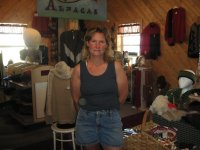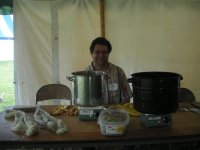I was accepted into the Presidential
Scholars Program in the fall semester of 2004, with Dr.
Bethany Usher from the Potsdam Anthropology Department as my
project adviser. My project involves experimental archeology: I am
trying to duplicate an ancient textile artifact in order to learn
more about the processes of its creation.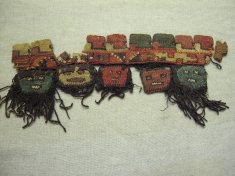 I am in the process of recreating a large cross-knit looped
fringed neckline border from the Early Intermediate Period of the
Nasca culture of southern Peru, A.D. 100-300, housed in the
collection of the Textile
Museum of Canada in Toronto, Canada. Re-creating an ancient
textile forges an intimate bond between the modern researcher and
artisans in the forgotten past. It requires assiduous academic
detective work and a leap of the imagination to produce an
educated guess in tactile form. Most of what we know about the
textile techniques of preliterate Andean cultures has come from
experimental reconstruction work by researchers such as Lila M.
O’Neale and Raoul d’Harcourt. I have done research about the
Nasca, the fibers and techniques they used to make their garments,
and the meaning that their textiles held for them. My project is
not actually an archaeological experiment, because I am not
controlling the variables to test a specific idea, but I have been
informed by the techniques of experimental archaeology, and the
experience of reproducing an ancient artifact will be a great
foundation for me in future experimental archeology and study of
textiles.
I am in the process of recreating a large cross-knit looped
fringed neckline border from the Early Intermediate Period of the
Nasca culture of southern Peru, A.D. 100-300, housed in the
collection of the Textile
Museum of Canada in Toronto, Canada. Re-creating an ancient
textile forges an intimate bond between the modern researcher and
artisans in the forgotten past. It requires assiduous academic
detective work and a leap of the imagination to produce an
educated guess in tactile form. Most of what we know about the
textile techniques of preliterate Andean cultures has come from
experimental reconstruction work by researchers such as Lila M.
O’Neale and Raoul d’Harcourt. I have done research about the
Nasca, the fibers and techniques they used to make their garments,
and the meaning that their textiles held for them. My project is
not actually an archaeological experiment, because I am not
controlling the variables to test a specific idea, but I have been
informed by the techniques of experimental archaeology, and the
experience of reproducing an ancient artifact will be a great
foundation for me in future experimental archeology and study of
textiles.
NASCA HISTORY
Nasca culture flowered in the Early Intermediate Period of southern Peru, from about 1 A.D. to 700 A.D., but most visible traces of their culture had vanished by the time the Spanish conquered the Inca in 1532, according to Helaine Silverman and Donald Proulx in their book, The Nasca. Although our understanding of the Nasca culture has increased with a recent change in research focus from the stylistic changes in their artifacts to their society, their civilization is still a mystery to us. Much of what we know about how they lived derives from the remains they left behind, as well as a certain amount of ethnoarchaeological analogy.
 The
Río Grande de Nazca drainage basin where the Nasca lived is
described as a "sub-tropical desiccated desert," and at
first glance it does not appear to be particularly hospitable to
human life (Silverman and Proux 43). However, the Nasca seem to
have made the most of their environment, transforming the desert
into a verdant, productive agricultural economy. Like the
Egyptians, they took advantage of annual floods, and grew maize,
manioc, achira, lima beans, guava, lúcuma, and jíquima.
They were able to move beyond strict subsistence, producing items
with aesthetic as well as functional qualities; they might even
have had a specialized ceramic-making artisan class.
The
Río Grande de Nazca drainage basin where the Nasca lived is
described as a "sub-tropical desiccated desert," and at
first glance it does not appear to be particularly hospitable to
human life (Silverman and Proux 43). However, the Nasca seem to
have made the most of their environment, transforming the desert
into a verdant, productive agricultural economy. Like the
Egyptians, they took advantage of annual floods, and grew maize,
manioc, achira, lima beans, guava, lúcuma, and jíquima.
They were able to move beyond strict subsistence, producing items
with aesthetic as well as functional qualities; they might even
have had a specialized ceramic-making artisan class.
Nasca artistic expression, like that of other PreColumbian cultures, was initially attributed to the Inca. With further study it became clear that their work represented a unique and fascinating society. The aspect of Nasca expression that has received the most popular and subsequent scholarly attention is the pattern of mysterious geoglyphs that they created across their arid landscape. These environmental artworks have been the subject of many theories, both plausible and wildly improbable. The Nasca geoglyphs were created quite simply, by removing the dark stones that covered the ground, exposing the lighter soil underneath. Theorists have proposed that the lines were connected to water resources, that they represented the celestial calendar, that they were formed by ritual paths, or that they served as memory aids. Some have wildly proposed that extraterrestrials created the lines as markers or landing strips. Their main argument is that the "primitive" Nasca could not possibly have created the geoglyphs, because they cannot be seen from the ground. Others have posited that the Nasca must have had hot air balloon technology that allowed them to view the lines in progress. Researchers have answered their criticisms by noting that the Nasca regularly used grids to create their complex weavings, and that this technique could easily have been applied to the creation of the geoglyphs.
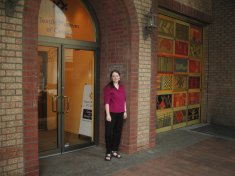 THE
TEXTILE'S SYMBOLISM
THE
TEXTILE'S SYMBOLISM
I first saw the Nasca textile in the Textile Museum of Canada's online exhibit Cloth and Clay: Communicating Culture. It consists of a narrow geometrically patterned band with square tabs attached above and below it. The stylized human faces are probably symbolic severed heads, while the upper tabs probably represent beans.
According to the material culture the Nasca left behind, trophy heads or severed heads were very significant in their culture. Headhunting was an important feature of Nasca life. Their artistic expressions often featured trophy heads, to the extent that researchers can identify Nasca work based on depictions of their characteristic style of treating the severed head. According to Alan R. Sawyer, the trophy head cult originated some time before 200 B.C.E “in the jungle-shrouded valleys of Amazon tributaries that cut deep into Peru’s southern highlands.” After it was introduced to the Nasca, it became extremely popular, superseding the original Nasca religion. “The Nasca and Necropolis cultures evidently regarded the head as the residence of human vitality since, when it was injured, the body could not function. The trophy head was therefore believed to retain life force” (47). High-status people often wore textiles representing severed heads or even real severed heads around their waists. Nasca trophy heads had the hole in the foramen magnum widened to permit the brain to pass through, and a small hole in the frontal bone for the convenient carrying cord. The lips of the heads were sealed with cactus spines and the jaws were lashed together, and the apertures for the eyes and cheeks were stuffed with cotton.
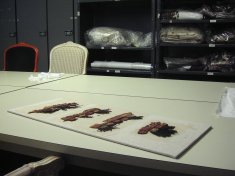 VISIT
TO THE TEXTILE MUSEUM OF CANADA
VISIT
TO THE TEXTILE MUSEUM OF CANADA
I visited the Textile Museum of Canada in June, 2005 to view the textile up close. The assistant curator, Roxane Shaughnessy, had laid the textile out for me to examine visually: it is too delicate to handle except for conservation. It was a very exciting experience for me to be able to look at a nearly two thousand year old textile up close, without glass or any protective material covering it. As I took notes about the textile, I couldn't help but feel awed by its sheer age and the skill used to construct it.
The provenance of the textile artifact is a bit of a mystery. Given its state of preservation, it was probably buried in a sand dune grave along with other grave goods. Textiles only preserve in unusually waterlogged, arid, or cold environments that protect them from decomposition. In 1889, William H. Holmes wrote: “The ancient inhabitants of Peru, as is customary with many peoples of corresponding grades of culture, buried a multitude of useful and valued objects along with the dead, and it happened that the dry sands in which the tombs were excavated, preserved, through a process of desiccation, not only the bodies but most of the fragile articles and delicate fabrics that accompanied them” (5). After it was recovered from the burial, either legally or by looters, the edging was probably sold in a textile auction. Although it originally edged a sleeve or neckline, it was found sewn to the center of a larger dark-blue cloth, which is commonly done to increase the value of auction items. To learn more about the history of this textile, click here.
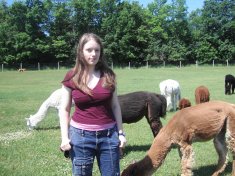 SPINNING
THE ALPACA FIBER
SPINNING
THE ALPACA FIBER
The textile is made from handspun two-ply alpaca yarn, so I visited a local alpaca farm, Angel Knoll Alpacas, in order to get some alpaca fleece. Angel Dunkelberg generously gave me two full fleeces and a number of smaller bags of alpaca fleece, requesting only that I make something in return for the Angel Knoll gift shop. I decided to make a shawl for her, but that's another story.
In South America, alpaca are sheared in the spring. Rather than carding the wool, women draw the fibers out into a roving by hand. They often wind the roving around a forked wooden distaff or their lower arms. Mary Elizabeth King states, “The Peruvians used spindles of thorn and wood with or without spindle whorls of pottery, stone, or wood.” Many of my sources rhapsodized over the skill of the Andean spinners, the incomparable fineness and evenness of their yarns. Although this intimidated me, I did my best to spin a fine, even yarn, aided by the smoothness and fineness of the alpaca fiber I was spinning.
Women were the primary household spinners, as Jane Feltham describes: “The spinner makes a small length of yarn by twisting together some fibres with her fingers. She attaches this to the spindle, which she twirls and drops, while drawing out the fibres from roving with the thumb and forefinger of her other hand. As the yarn is spun, it is wound on to the spindle” (17-18). Yarns can be spun either clockwise or counterclockwise so that the final twist resembles the letter “S” or “Z” when viewed from the side. In most places, including Peru, yarns are plied in the opposite direction of the twist used to spin them. Feltham continues, “The direction of spin and ply have varied over time and place and can be important in identifying the provenance of certain textiles. Wool, both then and now, is almost always Z-spun and S-plied. The direction of the spin of cotton varies. In the highlands today woollen yarns spun with an S twist are called lloq’e and deemed to have magical properties” (19).
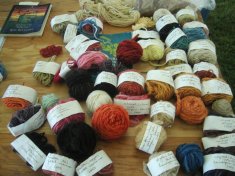 DYEING
THE YARN
DYEING
THE YARN
Like many PreColumbian Andean cultures, the Nasca were master natural dyers and used the natural variation in alpaca colors to get the greatest variation in hues. According to Jose Antonio de Lavalle and Jose Alejandro Gonzalez Garcia, “Colors were obtained from four general sources. First, from the natural shades of wool and cotton which yielded a wide variety: ivory whites, lustrous blacks, rich umbers, cool greys and mustard-like fawns from the wool of the camelids, and a lilac-tinted grey, various shades of brown, white and beige from the species of cotton, gossypium barbadense, that grows indigenously in Peru. Secondly, from certain plants... referred to by some of the Spanish chroniclers... Colors were also obtained from certain insects and molluscs: the cochineal, for example, which is found in opuntia fields, and whose crushed powder provides a carmine red, or the chanque, a small marine creature which excretes a purplish liquid and which is native to such areas as the Paracas peninsula. Finally, certain earth tones appear to have been obtained from rock and mineral sources...” (60).
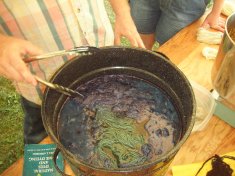 Many
of the natural plant dyes the ancient Nasca used are still widely
used today: Brazilwood, known to the Nasca as “brasil”
(Caesalpinia echinata), cochineal, known as “magno” or
“macno” (Dactylopius coccus), indigo, known as
“xiquilite” (Indigofera suffruticosa), and walnut
(Juglans sp.). A satisfactory green dye is hard to find in
nature, so many cultures worldwide, including the Nasca, have
overdyed yellow yarns with blue to obtain bright green. I had the
opposite problem with yellow dye, which is so easy to obtain that
dyers use local plants. The Nasca would have used a variety of
local plants, including Peruvian false peppertree (Schinus
molle), Holy or Blessed thistle (Cnicus benedictus),
“chillca” or “chillka” (Baccharis prostata or
salicifolia), and Spanish Needle, known as “quico” (Bidens
andicola). I used authentic dyes where possible, but I had to
replace the yellow with a local dye of my own: goldenrod.
Many
of the natural plant dyes the ancient Nasca used are still widely
used today: Brazilwood, known to the Nasca as “brasil”
(Caesalpinia echinata), cochineal, known as “magno” or
“macno” (Dactylopius coccus), indigo, known as
“xiquilite” (Indigofera suffruticosa), and walnut
(Juglans sp.). A satisfactory green dye is hard to find in
nature, so many cultures worldwide, including the Nasca, have
overdyed yellow yarns with blue to obtain bright green. I had the
opposite problem with yellow dye, which is so easy to obtain that
dyers use local plants. The Nasca would have used a variety of
local plants, including Peruvian false peppertree (Schinus
molle), Holy or Blessed thistle (Cnicus benedictus),
“chillca” or “chillka” (Baccharis prostata or
salicifolia), and Spanish Needle, known as “quico” (Bidens
andicola). I used authentic dyes where possible, but I had to
replace the yellow with a local dye of my own: goldenrod.
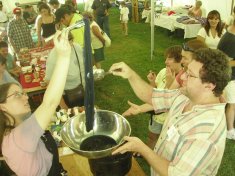 I
enlisted the help of a local natural dye enthusiast, Dr. Lance
Myler, to do my dyeing. I premordanted some of the yarns with
alum. The Nasca would also have used iron and urine, as well as
“such mordants as oxalic acid, tannin products, ashes, fermented
black mud that could be rich in iron salts, in tannin and in
tannates... copper sulphates and river salts, apart from copper
sulphate which is blue vitriol” (Lavalle and Garcia 60). We dyed
the yellow, blue, and green yarn at the North
Country Folklife Festival in Massena, demonstrating natural
dyeing for the Almanzo
Wilder House. Several times, the literature about the Nasca
stated that the Nasca could have overdyed natural fawn alpaca
fleece with indigo to create blue. I tested this assertion and
found that it only produced a duller blue, so I don't believe that
the Nasca with their love of bright color would have done this.
I
enlisted the help of a local natural dye enthusiast, Dr. Lance
Myler, to do my dyeing. I premordanted some of the yarns with
alum. The Nasca would also have used iron and urine, as well as
“such mordants as oxalic acid, tannin products, ashes, fermented
black mud that could be rich in iron salts, in tannin and in
tannates... copper sulphates and river salts, apart from copper
sulphate which is blue vitriol” (Lavalle and Garcia 60). We dyed
the yellow, blue, and green yarn at the North
Country Folklife Festival in Massena, demonstrating natural
dyeing for the Almanzo
Wilder House. Several times, the literature about the Nasca
stated that the Nasca could have overdyed natural fawn alpaca
fleece with indigo to create blue. I tested this assertion and
found that it only produced a duller blue, so I don't believe that
the Nasca with their love of bright color would have done this.
We dyed the red yarns with cochineal mixed with nitric acid to change the normal rose color of cochineal dye to red. The Nasca would have used acidic lime juice to modify their natural dyes. The first dyeing was a bit light, so I redyed it with another bath of cochineal for a nice deep red. I may also test the Brazilwood dye on one of the skeins, because one of my sources mentioned that the Nasca would combine cochineal and Brazilwood dyes (although a chemical analysis I read stated that the Nasca never combined the two dyes).
CROSS-KNIT LOOPING
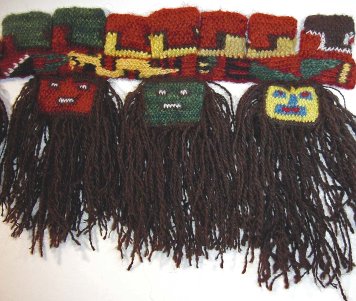 Cross-knit
looping has often been mistaken for crossed knitting in the
archaeological record. In the late 19th century,
William Holmes did not even attempt to understand the subtle
differences between cross-knit looping and knitting: “Knitting
was common also [among the Nasca], but, as the interloopings are
very difficult to describe, I will not now undertake to analyze
them” (15). Later, Lila M. O'Neale, Raoul d'Harcourt, and other
researchers made experimental recreations of the technique with a
needle and yarn to understand its construction better. Although
cross-knit looping and crossed knitting appear similar in the
finished product, cross-knit looping uses a sewing needle to form
a looped fabric, whereas crossed knitting uses two longer knitting
needles to form an interlooped fabric. Cross-knit looping has also
been referred to as “Needleknitting, Knit-stem stitch, Chain
stitch, and Countered-stem stitch” (Lavalle and Garcia 296). The
Nasca used cross-knit looping in camelid fibers to ornament the
edges of woven cotton garments. Sometimes the cross-knit looping
was three-dimensional, while in other textiles like the one I
copied, it was used to form flat tabs.
Cross-knit
looping has often been mistaken for crossed knitting in the
archaeological record. In the late 19th century,
William Holmes did not even attempt to understand the subtle
differences between cross-knit looping and knitting: “Knitting
was common also [among the Nasca], but, as the interloopings are
very difficult to describe, I will not now undertake to analyze
them” (15). Later, Lila M. O'Neale, Raoul d'Harcourt, and other
researchers made experimental recreations of the technique with a
needle and yarn to understand its construction better. Although
cross-knit looping and crossed knitting appear similar in the
finished product, cross-knit looping uses a sewing needle to form
a looped fabric, whereas crossed knitting uses two longer knitting
needles to form an interlooped fabric. Cross-knit looping has also
been referred to as “Needleknitting, Knit-stem stitch, Chain
stitch, and Countered-stem stitch” (Lavalle and Garcia 296). The
Nasca used cross-knit looping in camelid fibers to ornament the
edges of woven cotton garments. Sometimes the cross-knit looping
was three-dimensional, while in other textiles like the one I
copied, it was used to form flat tabs.
RESULTS
I presented a paper entitled “Re-creation of a Nasca Cross-Knit-Looped Edging” at the 2006 Textile Society of America Symposium, which was held at the Textile Museum of Canada. This conference was a great opportunity for me to network with textile professionals and attend other presentations. I got the chance to speak with experts on Andean textiles and benefit from their experience. Through the Presidential Scholars Program, I also attended the Northeastern Anthropological Association meeting in Lake Placid, April 3- 6, 2005, where a paper I co-authored was presented. I presented my project at the Spring Colloquium for the Presidential Scholars Program in April 2007.
ACKNOWLEDGEMENTS
Being part of the SUNY Potsdam Presidential Scholars Program has given me a great opportunity to combine my academic and extracurricular interests. Through financial and academic support, it has allowed me to explore undergraduate research and gain experiences I could never have had without the program's backing. I would also like to thank Dr. Bethany Usher, Dr. Patricia Whelehan, Ms. Roxane Shaughnessy, Ms. Angel Dunkelberg, Dr. Lance Myler, and Heather Nelson for their help with my project.



